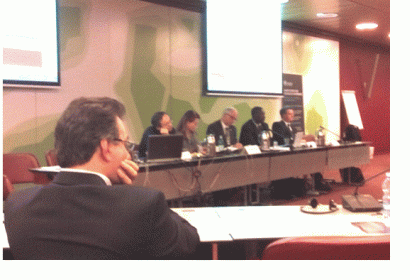From 27 to 29 January 2016, the United Nations Office for Disaster Risk Reduction (UNISDR) is conducting the UNISDR Science and Technology Conference on the Implementation of the Sendai Framework for Disaster Risk Reduction 2015-2030. The Conference, held in the International Conference Centre Geneva (CICG), aims to promote the application of science and technology in Disaster Risk Reduction efforts (DRR) worldwide. UNISDR will use this Conference to launch the UNISDR Science and Technology Partnership for the implementation of the Sendai Framework and to outline how science and technology efforts should be incorporated in the four priority areas of action included in the Sendai framework.
The UNISDR Science and Technology Conference is structured in terms of two high level panels and four work streams. Work stream 1 addresses the topic of scientific and technical partnerships to support the implementation of the Sendai Framework. Three panels are included in this work stream, including one on the topic of Local, National, Regional and International Partnerships. Mr. Luc St Pierre, Senior Programme Officer of the United Nations Office for Outer Space Affairs (UNOOSA) and Coordinator of the UN-SPIDER Programme participated in this panel. Other organizations invited to participate in this panel included the International Council for Science (ICSU), the Integrated Risk Governance Project for Future Earth (IRG-Project), and the International Research Disaster Reduction programme (IRDR).
In his remarks, Mr. St Pierre made reference to the role of UNOOSA and UN-SPIDER in mobilizing the space community to contribute to the implementation of the Sendai framework; to the contributions of the space community to DRR efforts through Earth observation, satellite telecommunications and Global Navigation Satellite Systems (GNSS). He also made the audience aware of the Global Earth Observation Partnership that was launched during the Sendai Conference by UNOOSA and 17 partners including UN and other international and regional organizations, national space agencies and national disaster risk reduction committees or agencies. This partnership aims to enhance the use of space-based applications in DRR efforts, to develop novel applications, and to facilitate the dialogue among stakeholders in Earth Observation, satellite-based technologies and the global community of DRR experts and policy makers.
Mrs. Simonetta Di Pippo, Director of UNOOSA, and Mr. Joachim Post of the UN-SPIDER team, are also attending the conference and will use the opportunity to meet with partners from regional and international organizations and with representative of national government agencies to discuss ongoing and future activities. Additional information on this UNISDR Science and Technology Conference is available in the following link: http://www.unisdr.org/partners/academia-research/conference/2016/

